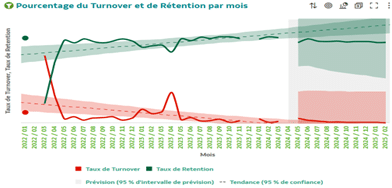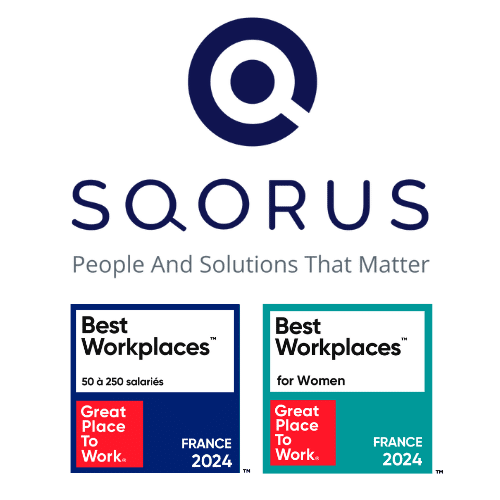Notre analyse ne se limite pas à l’outil FDI lui-même, mais s’inscrit dans une compréhension globale des solutions disponibles pour le HR Reporting. C’est pourquoi nous vous invitons également à consulter notre étude connexe qui examine en détail en premier lieu les fonctionnalités clés de différents outils tels que OTBI et BIP, FDI offrant ainsi une perspective enrichissante sur l’écosystème du HR Reporting.
Pour une exploration exhaustive du sujet, nous avons également développé une analyse dédiée à la méthodologie du HR Reporting, dimension fondamentale qui complète notre examen des outils et des compétences nécessaires.
Plongeons ensemble dans cette analyse approfondie qui vous aidera à prendre des décisions stratégiques basées sur des données RH fiables et pertinentes pour votre organisation.
L’importance de la compréhension des données RH et des processus métier
L’analyse approfondie des données RH révèle des tendances et des opportunités qui, autrement, resteraient invisibles. Elle permet d’anticiper les besoins organisationnels et d’élaborer des stratégies RH pertinentes. Parallèlement, la connaissance fine des processus métier facilite l’optimisation des opérations et l’identification des inefficacités.
Les compétences essentielles pour maîtriser le HR Reporting avec FDI
Pour réussir dans le domaine complexe du HR Reporting, plusieurs compétences clés sont nécessaires.
- La maîtrise technique des outils informatiques et des logiciels de Reporting est fondamentale.
- Une capacité d’analyse approfondie est indispensable pour interpréter les données au-delà des chiffres et des tableaux.
- La connaissance des processus RH est également cruciale pour contextualiser les données dans le cadre des opérations RH.
- Enfin, une communication clairvoyante est essentielle pour présenter les résultats de manière claire et concrète, permettant ainsi une prise de décision éclairée.
Les compétences techniques requises pour utiliser efficacement FDI
Pour exploiter pleinement FDI, il est essentiel de bien comprendre la plateforme, y compris son interface utilisateur, ses fonctionnalités d’analyse avancée et ses capacités d’intégration des données. Cette connaissance approfondie est la base sur laquelle repose toute utilisation efficace de FDI.
Les compétences en manipulation et modélisation des données sont également cruciales. Les utilisateurs doivent être capables de combiner des données de diverses sources, de modéliser les données de manière avancée et de gérer des ensembles de données complexes à grande échelle.
Une compréhension approfondie des capacités d’analyse avancée, y compris la visualisation et l’exploration des données en libre-service, est indispensable. Les utilisateurs doivent être en mesure d’intégrer différentes sources de données pour créer des tableaux de bord interactifs, des rapports et des récits de données.
Enfin, l’intégration de capacités d’apprentissage automatique pour l’analyse prédictive constitue un atout précieux. Les utilisateurs doivent être en mesure de tirer parti de ces fonctionnalités pour optimiser leurs décisions stratégiques et améliorer les performances de leur entreprise.
Les avantages de l’intégration FDI avec les systèmes RH existants
Vue holistique des données RH : Consolidant les données RH dispersées à travers divers systèmes dans FDI, votre entreprise bénéficiera d’une vue holistique et unifiée de sa main-d’œuvre. Cette consolidation permet une analyse approfondie des tendances et des performances des employés, fournissant ainsi des insights précieux pour une prise de décision éclairée.
Analyse prédictive pour une planification stratégique : FDI offre des capacités d’analyse prédictive avancées, permettant à votre entreprise d’anticiper les besoins en matière de recrutement, de formation et de rétention des talents. Cette capacité à planifier stratégiquement en fonction des données prédictives donne à votre entreprise un avantage concurrentiel significatif sur le marché du travail.
Optimisation des processus RH : L’intégration de FDI avec vos systèmes RH existants permet une optimisation des processus RH. Grâce à une automatisation accrue et à des workflows rationalisés, votre entreprise peut réduire les inefficacités opérationnelles, économiser du temps et des ressources, et se concentrer davantage sur la création de valeur pour ses employés et ses clients.
Personnalisation et flexibilité : FDI offre une flexibilité et une personnalisation exceptionnelles, vous permettant de configurer des tableaux de bord et des rapports personnalisés selon les besoins spécifiques de votre entreprise. Cette capacité à adapter les analyses et les rapports en fonction de vos objectifs commerciaux uniques renforce votre agilité et votre capacité à répondre aux défis changeants du marché.
Capacités d’analyse avancée FDI pour les données RH
Analyse prédictive : Grâce à ses fonctionnalités d’analyse avancée, la solution permet de prédire avec précision les tendances futures du marché du travail et les comportements des employés. En utilisant des algorithmes sophistiqués, FDI peut anticiper les besoins en talents, les schémas de rotation du personnel et même prédire les performances des employés, offrant ainsi aux entreprises un avantage concurrentiel crucial.
Découverte de modèles : FDI excelle dans la découverte de modèles complexes au sein des données RH. En utilisant des techniques d’apprentissage automatique, l’outil peut identifier des schémas cachés et des corrélations entre différentes variables, permettant aux entreprises de découvrir de nouvelles perspectives sur leur main-d’œuvre et de prendre des décisions plus éclairées en conséquence.
Cas pratiques : comment FDI transforme l’analyse des données RH ?
Analyse prédictive des départs : anticiper pour mieux retenir
Notre analyse des départs de personnel se concentre sur deux indicateurs clés : les fins de contrat volontaires et non volontaires. Notre approche méticuleuse se démarque par le choix avisé des dimensions et des types de visualisation.
La visualisation présente l’évolution mensuelle sur les 12 derniers mois. Les courbes tracées fournissent une clarté visuelle immédiate, offrant une lecture immédiate des tendances.
Pour enrichir cette représentation, nous avons exploré la valeur ajoutée de l’intégration de statistiques, en ajoutant une prévision sur les 3 prochains mois. Cette dimension prédictive élargit notre compréhension en offrant une vision prospective des tendances à venir et permet de préparer les actions nécessaires.
Cette approche combinant analyse rétrospective et prédictive donne aux décideurs une vision complète pour piloter efficacement leur stratégie de rétention des talents.

Prévision à long terme du turnover : planifier l’avenir RH avec précision
FDI permet de visualiser simultanément le taux de turnover et le taux de rétention mensuel, offrant une vue complète des mouvements de personnel.
L’atout majeur de cette analyse réside dans sa capacité à projeter ces indicateurs sur les 10 prochains mois. En élargissant l’échelle temporelle, nous offrons une perspective étendue, permettant aux décideurs d’anticiper les tendances à moyen terme et de planifier en conséquence.
Pour renforcer la clarté de cette analyse, une courbe en tirets est incorporée, illustrant la tendance directionnelle des données. Cette fonctionnalité offre une vision stratégique, permettant de déceler rapidement les évolutions du personnel et d’ajuster les politiques et pratiques de gestion des ressources humaines en conséquence.

Clustering des données RH : identifier les profils à risque par grade et ancienneté
FDI offre également la possibilité de réaliser un clustering ou partitionnement des données pour une analyse plus approfondie.
Cette technique visualise les groupes de salariés par grade, en analysant le taux de turnover en croisant l’ancienneté moyenne et l’âge moyen, définissant ainsi la taille et la composition de chaque cluster.
Elle permet une compréhension claire et concise des dynamiques du personnel selon différents paramètres clés, offrant ainsi des insights précieux pour une gestion stratégique des ressources humaines.

Conclusion
En investissant dans la compréhension approfondie de FDI, les entreprises peuvent s’assurer un avantage compétitif crucial dans le paysage en constante évolution des ressources humaines.
HR Data strategy: what if we accelerated?
Imagine a world where the HR function is propelled into a new dimension thanks to the power of data. What if this world were within our reach? Discover how to harness the full potential of HR Data to revolutionize your organization.









